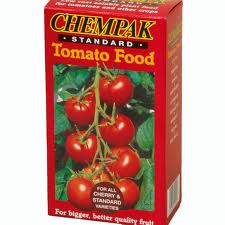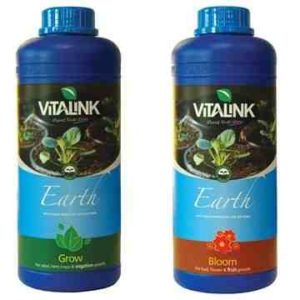Standard Tomato Food – Dry Nutrients
One of the best traditional feeds for tomato plants is Chempak Standard Tomato Food. This has been voted number one in a number of polls including a Which magazine poll.

However, whichever feed you use, it won’t be enough on its own to provide all that your plants need, though this one comes close to it because it is a dry compound that needs mixing with water.
If you look at the “ingredients” on the container of Tomorite, which is one of the most popular tomato foods, it doesn’t contain calcium … what! …. no calcium!
A liquid formula such as Tomorite has limits to the amount or type of nutrients it can contain and remain effective.
Tomorite is popular too!
We mentioned last week about nutrient competition where one nutrient will block out another. Well, the people who make Tomorite know (obviously!) that some nutrients just don’t mix together well, and that you could end up with calcium deficiency, whether calcium is in the product or not!
If you have good quality compost/soil and growing conditions are good, it may not be necessary to add extra nutrients like calcium because plants are able to access it in the soil contents.
That’s the theory, but the reality is often different and to rely totally on one feed like Chempak Standard or Tomorite, is taking a chance. Some seasons all will be fine, but more often than not, there’ll be problems.
So What’s The Answer?
If you are growing a medium or large variety in a container or grow bag, the chance of nutrient deficiency especially Blossom End Rot is high, see below.

The best way to avoid nutrient deficiency is to provide tomato plants with a “grow” feed up until the flowers begin to set, then a “fruiting” feed when the tomatoes begin to appear. This way plants get exactly what they need when they needs it and the soil doesn’t become over-fed with nutrients that plants don’t need.
A very good product for organic growers is Bio-Grow and Bio-Bloom for the grow and fruiting stages. These are from the BioBizz range of nutrients.

For non-organic gardeners, Vitalink’s Earth – Growth and Bloom formulas are excellent.
Next week we’ll discuss nutrient additives which boost specific growth processes.
Note: If you are growing cherry tomatoes you may not need to worry too much about calcium deficiency and nutrient block because cherry tomatoes are unlikely to get Blossom End Rot because they need less calcium than their bigger cousins!
I highly recommend a foliar feed with calcium when plants begin to fruit if growing medium and large varieties. Chempak Calcium and Vitalink’s Foliar are both excellent.
Many suggest that spraying with milk is a good way to get calcium into a plant!


jess allaway
Hi Nick,
Seeing Allan’s comment above made me wonder if it might be a good idea for me, since I live on the Argyllshire coast, to give a top dressing to my toms made up of finely crushed seashells. I believe shells are composed mainly of calcium. This would also reflect light up into the plants. What do you think? Or am I just looking for an excuse to go beach combing!
Roy
How often do you feed with Vitalink’s Earth – Growth and what dosage
Nick
Hi Roy,
When plants are absorbing plenty of moisture in warm weather, I would use the Vitalink Earth every other watering at 3-4ml per litre – if growing in soil. I would also feed by foliar spray, nutrient boosts at the times when the plants need a bit of extra help, such as Vitalink’s Foliar and Buddy.
Regards,
Nick
Mark D
Maybe add a little hydrated lime or crushed limestone to the potting mix? These are largely calcium hydroxide and calcium carbonate, respectively, so should be an ideal source of Ca.
Nick
Thanks for the tips Mark!
Sue Heyer, Switzerland
Hi Nick
Our water contains lots of calcium (water in the electric kettle is white after being boiled). Would this water be any good to supply my tomatoes with calcium?
Best wishes
Sue
Nick
Hi Sue,
You live in a hard water area if you have crusty bits around the heating element of your kettle. This shows that the water contains more minerals than a soft water area. I don’t think that even if the water contains calcium, it would be in a sufficient amount to spray on the tomatoes and avoid blossom end rot, but to be honest – I can’t say for sure!
If some of your toms suffer from BER each season it would be worth spraying some plants with water and not others, to see if it makes a difference.
Best wishes,
Nick
allan
for me i use a two litre bottle of water and break up egg shells in it leave it a week or two and it is a perfect way of giving calcium you can also just break the egg shells up into the soil i saw it on beechgrove years ago and have used it and tormite since but might give chempak a try on a few to see if there is a difference